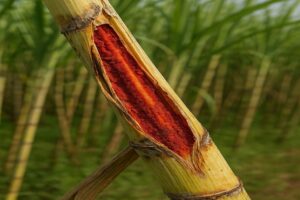Sugarcane is a major cash crop in many countries, especially in South Asia. However, one of the most destructive diseases affecting sugarcane production is Red Rot Disease. This fungal infection significantly reduces yield and can cause heavy economic losses for farmers.
What is Red Rot Disease?
Red rot is a fungal disease caused by Colletotrichum falcatum. It affects the stalks of sugarcane and leads to internal tissue damage, resulting in poor juice quality and crop failure.
Causes of Red Rot Disease:
-
High humidity and rainfall during the growing season.
-
Poor drainage in the field.
-
Use of infected setts (sugarcane cuttings).
-
Continuous cultivation of susceptible sugarcane varieties.
Symptoms of Red Rot in Sugarcane:
-
Yellowing and drying of top leaves.
-
Red-colored patches inside the cane when split open.
-
Foul smell from the infected stalks.
-
White patches and cavities in advanced stages.
-
Wilting and eventual death of the plant.
️ Control and Prevention Methods:
1. Use Resistant Varieties:
Choose disease-resistant sugarcane varieties recommended by agricultural experts.
2. Seed Treatment:
-
Soak sugarcane setts in a fungicide solution (e.g., Carbendazim 0.1%) for 10 minutes before planting.
3. Crop Rotation:
-
Avoid continuous sugarcane cultivation in the same field. Rotate with crops like legumes.
4. Field Sanitation:
-
Remove and destroy infected plants immediately.
-
Maintain good drainage in the field.
5. Biological Control:
-
Use Trichoderma viride as a biological fungicide in the soil.
Lab Testing:
If symptoms appear, send samples to an agricultural lab for confirmation and targeted treatment advice.
Impact on Yield:
If not controlled early, Red Rot can reduce sugarcane yield by 30% to 70%, and in severe cases, wipe out entire fields.



